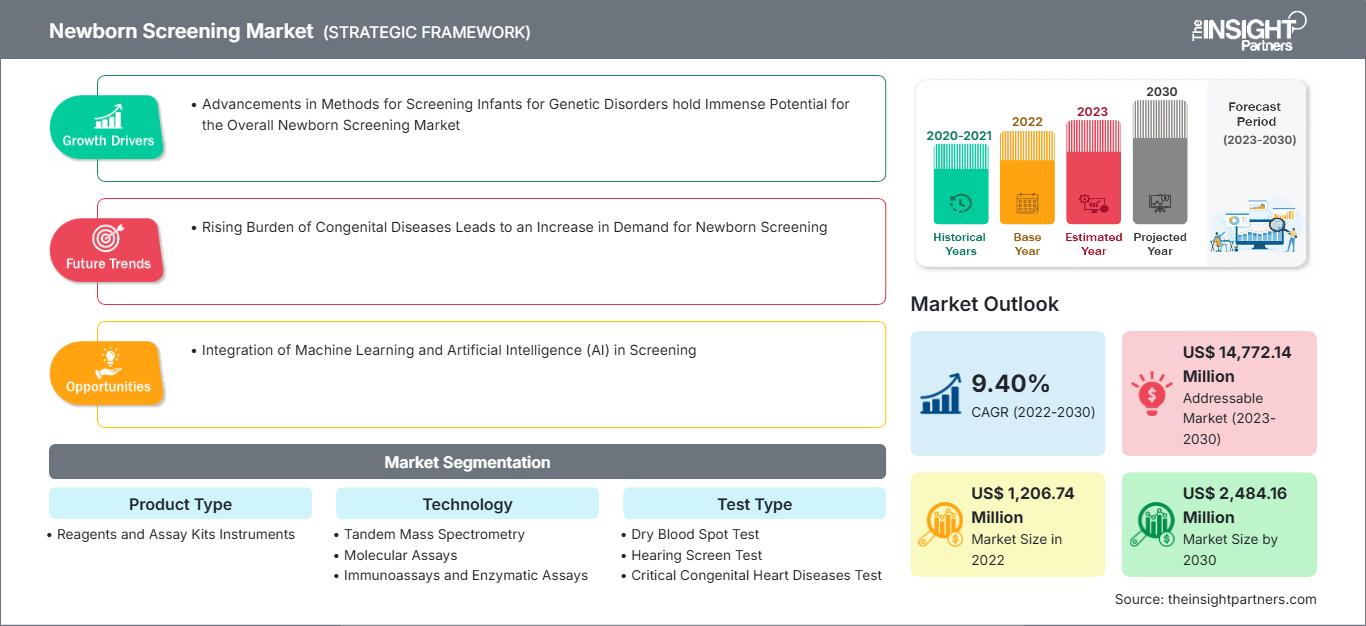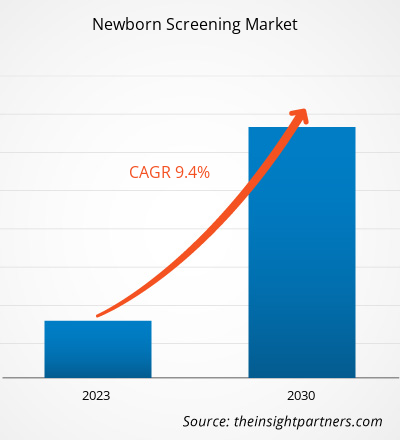新生儿筛查市场规模预计将从 2022 年的 12.0674 亿美元增至 2030 年的 24.8416 亿美元。预计该市场在 2022 年至 2030 年期间的复合年增长率为 9.40%。机器学习和人工智能 (AI) 在筛查中的整合可能仍将是市场的主要趋势。
新生儿筛查市场分析
随着政府和非营利组织的教育活动,公众和医疗保健提供者对新生儿疾病早期诊断和干预价值的认识不断提高,预计市场将会增长。此外,出生率的提高也推动了新生儿筛查的需求,尤其是在发展中国家。新生儿筛查市场的利益相关者可以利用这些驱动因素和机会,改善早期发现和干预,并最终改善全球新生儿的健康状况。
新生儿筛查市场概览
各国政府都在增加对新生儿筛查项目的拨款。这些项目有助于降低儿童及其父母的长期医疗保健成本,因为先天性和遗传性疾病如果未能发现,可能会导致严重的健康并发症,并需要大量的医疗干预。通过识别和解决婴儿期的健康问题,政府可以增进公民的健康和福祉。因此,新生儿筛查与更广泛的公共卫生目标相一致,旨在改善整体人口健康状况并减轻医疗保健系统的负担。
政府资金促进了医疗保健服务的公平性,确保所有人都能获得新生儿筛查服务,无论其社会经济地位如何。这种包容性对于早期疾病检测和干预至关重要,因为它可以防止不同人口群体之间医疗保健结果的差异。随着各国政府继续通过增加资金和政策支持将新生儿筛查列为优先事项,全球婴儿筛查市场一直在持续增长。
自定义此报告以满足您的要求
您将免费获得任何报告的定制,包括本报告的部分内容,或国家级分析、Excel 数据包,以及为初创企业和大学提供超值优惠和折扣
新生儿筛查市场: 战略洞察

- 获取本报告的主要市场趋势。这个免费样本将包括数据分析,从市场趋势到估计和预测。
您将免费获得任何报告的定制,包括本报告的部分内容,或国家级分析、Excel 数据包,以及为初创企业和大学提供超值优惠和折扣
新生儿筛查市场: 战略洞察

- 获取本报告的主要市场趋势。这个免费样本将包括数据分析,从市场趋势到估计和预测。
新生儿筛查市场驱动因素和机遇
先天性疾病负担加重导致新生儿筛查需求增加,利于市场增长
如果不能及早发现和管理,先天性疾病可能会导致终身健康问题。这些疾病会导致长期残疾,严重影响家庭、个人、医疗保健系统和社会。世界卫生组织估计,全球每年有 240,000 名新生儿在出生后 28 天内死于这些疾病。另外还有 170,000 名 1 个月至 5 岁之间的儿童死于先天性疾病。对许多先天性疾病遗传基础的了解不断加深是导致这些疾病负担加重的几个因素之一。基因组学和基因检测的进步使医疗保健提供者能够识别新生儿更广泛的基因突变和疾病。这些知识的扩展凸显了通过新生儿筛查进行早期诊断,以便及时开展干预和治疗的重要性。
不断变化的人口统计数据,例如母亲年龄、环境暴露和生活习惯的改变,都会增加新生儿患先天性疾病的风险。此外,由于全球人口的迅速增长,每天出生的婴儿数量也在不断增加,导致面临先天性疾病风险的婴儿群体不断扩大。此外,医疗保健系统和政策制定者认识到早期疾病检测的长期益处。他们越来越多地将新生儿筛查纳入常规医疗保健方案和保险范围,进一步刺激了市场增长。日益加重的先天性疾病负担是新生儿筛查市场发展的重要驱动力。
婴儿遗传疾病筛查方法的进步为整个新生儿筛查市场带来了巨大的潜力
随着对疾病遗传原因的认识不断深入以及医疗保健技术的进步,对新生儿进行全面基因筛查的需求也在不断增长。因此,新生儿筛查市场的公司正在开发创新且经济高效的筛查解决方案。美国食品药品监督管理局 (FDA) 于 2017 年批准 Kymriah 基因疗法用于治疗患有特定类型急性淋巴细胞白血病的儿科患者。在这种疗法中,一种编码嵌合抗原受体的新基因被插入患者的 T 细胞,刺激改变的 T 细胞追踪并摧毁白血病细胞。Yescarta 和 Zynteglo 是另外两个获得批准的用于治疗大 B 细胞淋巴瘤和 β-地中海贫血的基因疗法。此外,能够识别出生时疾病遗传易感性的技术也为个性化医疗保健铺平了道路,这与精准医疗的大趋势相契合。
妊娠期遗传病筛查也侧重于早期发现妊娠相关问题。新一代测序技术有助于新生儿产前筛查,其检测非整倍体(例如唐氏综合征和21三体综合征)或所有染色体的部分染色体异常(重复或缺失)的灵敏度超过95%。荧光原位杂交(FISH)技术可用于检测镰状细胞性贫血等单基因疾病,并有助于进行有效的胚胎植入前遗传学诊断。基因检测的最新进展包括一些非侵入性方法,例如使用母体血浆的无细胞胎儿DNA方法。胚胎DNA可以根据片段大小差异与母体DNA片段区分开来。荧光探针实时PCR、散弹枪测序(Solexa或Illumina)或大规模靶向平行测序可用于检测与胎儿疾病相关的DNA。这将使医生能够通过特定的药物疗法(药物遗传学)进行早期分子干预,并且如果进一步研究这种基因筛查,则可以从物理和化学角度改变细胞、组织和器官。因此,婴儿遗传疾病筛查方法的进步为整个新生儿筛查市场带来了巨大的潜力。
新生儿筛查市场报告细分分析
促成新生儿筛查市场分析的关键细分领域包括产品类型、技术、测试类型和最终用户。
- 根据产品类型,新生儿筛查市场分为试剂和检测试剂盒以及仪器。试剂和检测试剂盒细分市场在 2022 年占据了最大的市场份额。
- 按技术分类,市场分为串联质谱 (TMS)、分子检测、免疫测定和酶促测定、脉搏血氧饱和度筛查技术等。脉搏血氧饱和度筛查技术细分市场在 2022 年占据了最大的市场份额。
- 按测试类型,市场细分为干血斑测试、听力筛查测试、危重先天性心脏病 (CCHD) 测试等。 2022 年,干血斑检测细分市场占据了最大的市场份额。
- 按最终用户划分,市场分为医院和诊所以及诊断实验室。2022 年,医院和诊所细分市场占据了最大的市场份额。
新生儿筛查市场份额地域分析
新生儿筛查市场报告的地理范围主要分为五个区域:北美、亚太地区、欧洲、中东和非洲以及南美和中美。
近年来,北美新生儿筛查市场经历了显著增长。随着父母和医疗保健专业人员越来越意识到早期筛查对于识别和管理先天性疾病的重要性,对新生儿筛查服务的需求也显著增加。此外,医疗技术的进步对于提高新生儿筛查能力至关重要——实验室自动化提高了筛查的准确性、速度和成本效益。这使得医疗专业人员能够提供全面的新生儿筛查,涵盖更广泛的遗传和代谢疾病。有利的立法和监管措施也有利于北美的新生儿筛查市场。许多州和省都实施了强制性新生儿筛查计划,确保所有婴儿在出生后不久就接受筛查。例如,美国每个州都将新生儿筛查作为一项公共卫生计划;每年约有400万婴儿根据该计划接受筛查,以发现出生时通常不存在的疾病。德克萨斯州卫生与公众服务部于2021年6月开始对新生儿进行脊髓性肌萎缩症 (SMA) 筛查。
遗传异常和先天性疾病患病率的上升凸显了新生儿筛查的重要性。美国国立卫生研究院 (NIH) 向布法罗大学的一位研究人员提供了一项竞争激烈的 R01 拨款,用于领导一个国际项目,旨在显著提高对三种罕见且常致命的遗传疾病进行新生儿筛查的准确性。
此外,NIH 的尤妮丝·肯尼迪·施莱佛国家儿童健康与人类发展研究所也为这项为期五年、总额 380 万美元的拨款提供了资金。因此,随着人们意识的提高、技术的进步、政策的支持以及先天性疾病患病率的不断上升,北美的新生儿筛查市场正在蓬勃发展。
新生儿筛查市场区域洞察
The Insight Partners 的分析师已详尽阐述了预测期内影响新生儿筛查市场的区域趋势和因素。本节还讨论了北美、欧洲、亚太地区、中东和非洲以及南美和中美洲的新生儿筛查市场细分和地域分布。
新生儿筛查市场报告范围
| 报告属性 | 细节 |
|---|---|
| 市场规模 2022 | US$ 1,206.74 Million |
| 市场规模 2030 | US$ 2,484.16 Million |
| 全球复合年增长率 (2022 - 2030) | 9.40% |
| 历史数据 | 2020-2021 |
| 预测期 | 2023-2030 |
| 涵盖的领域 |
By 产品类型
|
| 覆盖地区和国家 | 北美
|
| 市场领导者和主要公司简介 |
|
新生儿筛查市场参与者密度:了解其对业务动态的影响
新生儿筛查市场正在快速增长,这得益于终端用户需求的不断增长,而这些需求的驱动因素包括消费者偏好的演变、技术进步以及对产品优势的认知度的提升。随着需求的增长,企业正在扩展产品线,不断创新以满足消费者需求,并抓住新兴趋势,从而进一步推动市场增长。

- 获取 新生儿筛查市场 主要参与者概述
新生儿筛查市场新闻和最新发展
新生儿筛查市场通过收集一手和二手研究后的定性和定量数据进行评估,这些数据包括重要的公司出版物、协会数据和数据库。新生儿筛查市场的一些发展如下:
- 雷迪儿童基因组医学研究所 (RCIGM) 宣布了一项新计划,旨在推进和评估一种名为 BeginNGS(发音为“beginnings”)的诊断和精准医疗指导工具的可扩展性,该工具使用快速全基因组测序 (rWGS) 对新生儿进行大约 400 种已知有治疗选择的遗传疾病筛查。BeginNGS 是通过与 Alexion、阿斯利康的罕见疾病集团、Fabric Genomics、Genomenon、Illumina, Inc. 的研究合作开发的;和 TileDB 使用 rWGS 在症状出现之前诊断遗传疾病并确定治疗方案,这比目前儿科使用 rWGS 的方法有了进步,因为儿科应用主要关注已经病情危重的儿童。(来源:Rady 儿童基因组医学研究所,新闻稿,2022 年 6 月)
新生儿筛查市场报告覆盖范围和可交付成果
“新生儿筛查市场规模和预测 (2020-2030)”报告提供了涵盖以下领域的市场详细分析:
- 新生儿筛查市场规模以及涵盖范围内所有关键细分市场的全球、区域和国家/地区预测
- 新生儿筛查市场趋势以及市场动态,例如驱动因素、限制因素和关键机遇
- 详细的 PEST/Porter 五力模型和 SWOT 分析
- 新生儿筛查市场分析涵盖关键市场趋势、全球和区域框架、主要参与者、法规和最新市场发展。
- 行业格局和竞争分析涵盖市场集中度、热图分析、知名参与者和新生儿筛查市场的最新发展
- 详细的公司简介
- 历史分析(2 年)、基准年、预测(7 年)及复合年增长率
- PEST和SWOT分析
- 市场规模、价值/数量 - 全球、区域、国家
- 行业和竞争格局
- Excel 数据集
近期报告
客户评价
购买理由
- 明智的决策
- 了解市场动态
- 竞争分析
- 客户洞察
- 市场预测
- 风险规避
- 战略规划
- 投资论证
- 识别新兴市场
- 优化营销策略
- 提升运营效率
- 顺应监管趋势




















 获取免费样品 - 新生儿筛查市场
获取免费样品 - 新生儿筛查市场